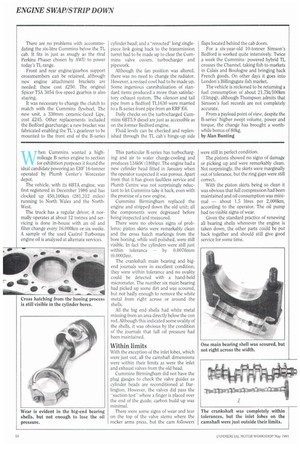W hen Cummins wanted a highmileage B-series engine to section for
Page 102

If you've noticed an error in this article please click here to report it so we can fix it.
exhibition purposes it found the ideal candidate powering an ERF 16-tonner operated by Plumb Center's Worcester depot.
The vehicle, with its 6BTA engine, was first registered in December 1986 and has clocked up 450,100km (281,312 miles) running to North Wales and the NorthWest.
The truck has a regular driver; it normally operates at about 12 tonnes and servicing is done in-house with an oil and filter change every 16,000km or six weeks. A sample of the used Castro] Turbomax engine oil is analysed at alternate services. This particular B-series has turbocharging and air to water charge-cooling and produces 134kW (180hp). The engine had a new cylinder head fitted in January when the operator suspected it was porous. Apart from that it has given faultless service and Plumb Centre was not surprisingly reluctant to let Cummins take it back, even with the promise of a new engine.
Cummins Birmingham replaced the engine and stripped down the old unit; all the components were degreased before being inspected and measured.
There were no obvious signs of problems; piston skirts were remarkably clean and the cross hatch markings from the bore honing, while well polished, were still visible. In fact the cylinders were still just within tolerance – by 0.0076mm (0.0003in).
The crankshaft main bearing and bigend journals were in excellent condition, they were within tolerance and no ovality could be detected with a hand-held micrometer. The number six main bearing had picked up some dirt and was scoured, but not badly enough to remove the white metal from right across or around the shells.
All the big end shells had white metal missing from an area directly below the con rod. Although this indicated some ovality of the shells, it was obvious by the condition of the journals that full oil pressure had been maintained.
Within limits
With the exception of the inlet lobes, which were just out, all the camshaft dimensions were within their limits as were the inlet and exhaust valves from the old head.
Cummins Birmingham did not have the plug gauges to check the valve guides as cylinder heads are reconditioned at Darlington. However, the valves did pass the "suction test" where a finger is placed over the end of the guide; carbon build up was minimal.
There were some signs of wear and tear on the top of the valve stems where the rocker arms press. but the cam followers were still in perfect condition.
The pistons showed no signs of damage or picking up and were remarkably clean. Not surprisingly, the skirts were marginally out of tolerance, but the ring gaps were still correct.
With the piston skirts being so clean it was obvious that full compression had been maintained and oil consumption was minimal — about 1.5 litres per 2,0001un, according to the operator. The oil pump had no visible signs of wear.
Given the standard practice of renewing all bearing shells whenever the engine is taken down, the other parts could be put back together and should still give good service for some time.












































































































